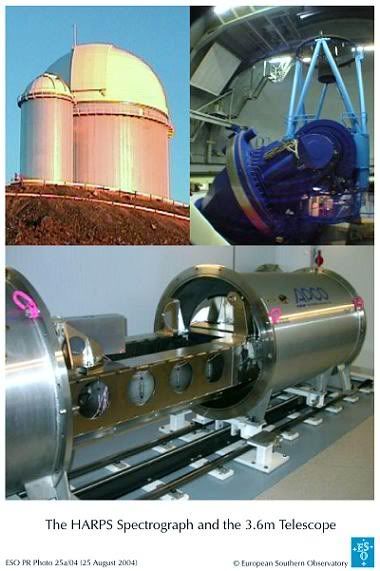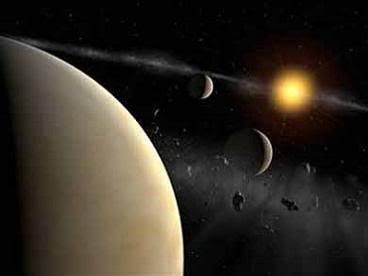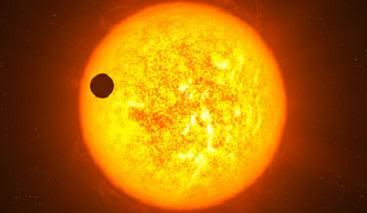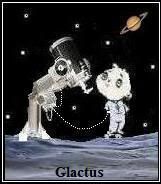Post by glactus on Oct 1, 2011 0:28:54 GMT
Astronomers have announced a whole new passel of planets orbiting stars near the Sun: 50 more, the single largest group ever announced at one time It’s an indication of just how good we’re getting at finding these things. Even better: many of these planets are at the upper end of what we might call Earth-like.

Harps spetrograph and 3.5m telescope
The instrument, called HARPS, for High Accuracy Radial velocity Planet Searcher, is a spectrograph. It takes light from distant objects and breaks it down into incredibly thin slices of wavelength, like a rainbow with a hundred thousand colors. A planet orbiting a star tugs on the star with its gravity, pulling it toward and away from us over the course of its orbit. This makes an incredibly small shift in the colors of the star, but well within the capability of HARPS to detect.

A star and plametary system
The team used HARPS (PDF) to survey 376 stars like the Sun (similar mass, size, and temperature) and found that 40% of them have at least one planet with less mass than Saturn. 40%! That’s incredible! Just doing some very rough math, 10% of the stars in the Milky Way could easily be called Sun-like. If 40% of those host planets the size of Saturn or smaller, there are billions of planets that size in our galaxy alone. That’s a whole lot of planets.

An xoplanet orbiting a sun like star
They also found that Neptune-mass planets appear to be common in multiple planet systems; in fact that’s apparently where the majority of them are. In other words, planets like Neptune are pretty easy to make, especially when there are other planets in the system.
16 of the 50 planets discovered by HARPS in this release are so-called "super-Earths", with masses a few times that of our home planet. Interestingly, you might expect them to have higher gravity than Earth since they’re more massive, but if they are also less dense, that is, bigger in size, then you might not weigh all that much more standing on the surface of one. For example, a planet with 5 times Earth’s mass but twice the radius would have a surface gravity only 20% higher than Earth; if you weighed 150 pounds here you’d weigh 180 pounds there.
Number of Xoplanets detected so far is listed below
13th May 2010, there are 453 known exoplanets.
6th December 2010 there are 506 known exoplanets.
7th January 2011 - 519 planets
9th February 2011 - 528 planets.
13th April 2011 - 540 planets.
10 May 2011 548 planets
13 June 2011 555 planets
22 June 2011 563 planets
And we’ll know better very soon. A new exoplanet-finding instrument is being built and will be operational in 2016. Called ESPRESSO — Echelle SPectrograph for Rocky Exoplanet and Stable Spectroscopic Observations — it’s an even more sensitive instrument than HARPS. It should be able to detect the planets with the same mass as Earth, well within their stars’ habitable zones. From another star, it could actually detect Earth orbiting the Sun!

Credits: These are non copywrite images
Text by Wikipedia

Harps spetrograph and 3.5m telescope
The instrument, called HARPS, for High Accuracy Radial velocity Planet Searcher, is a spectrograph. It takes light from distant objects and breaks it down into incredibly thin slices of wavelength, like a rainbow with a hundred thousand colors. A planet orbiting a star tugs on the star with its gravity, pulling it toward and away from us over the course of its orbit. This makes an incredibly small shift in the colors of the star, but well within the capability of HARPS to detect.

A star and plametary system
The team used HARPS (PDF) to survey 376 stars like the Sun (similar mass, size, and temperature) and found that 40% of them have at least one planet with less mass than Saturn. 40%! That’s incredible! Just doing some very rough math, 10% of the stars in the Milky Way could easily be called Sun-like. If 40% of those host planets the size of Saturn or smaller, there are billions of planets that size in our galaxy alone. That’s a whole lot of planets.

An xoplanet orbiting a sun like star
They also found that Neptune-mass planets appear to be common in multiple planet systems; in fact that’s apparently where the majority of them are. In other words, planets like Neptune are pretty easy to make, especially when there are other planets in the system.
16 of the 50 planets discovered by HARPS in this release are so-called "super-Earths", with masses a few times that of our home planet. Interestingly, you might expect them to have higher gravity than Earth since they’re more massive, but if they are also less dense, that is, bigger in size, then you might not weigh all that much more standing on the surface of one. For example, a planet with 5 times Earth’s mass but twice the radius would have a surface gravity only 20% higher than Earth; if you weighed 150 pounds here you’d weigh 180 pounds there.
Number of Xoplanets detected so far is listed below
13th May 2010, there are 453 known exoplanets.
6th December 2010 there are 506 known exoplanets.
7th January 2011 - 519 planets
9th February 2011 - 528 planets.
13th April 2011 - 540 planets.
10 May 2011 548 planets
13 June 2011 555 planets
22 June 2011 563 planets
And we’ll know better very soon. A new exoplanet-finding instrument is being built and will be operational in 2016. Called ESPRESSO — Echelle SPectrograph for Rocky Exoplanet and Stable Spectroscopic Observations — it’s an even more sensitive instrument than HARPS. It should be able to detect the planets with the same mass as Earth, well within their stars’ habitable zones. From another star, it could actually detect Earth orbiting the Sun!
Credits: These are non copywrite images
Text by Wikipedia


